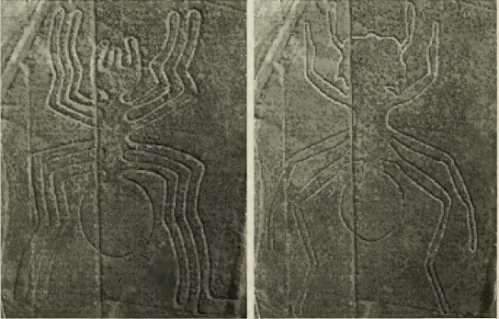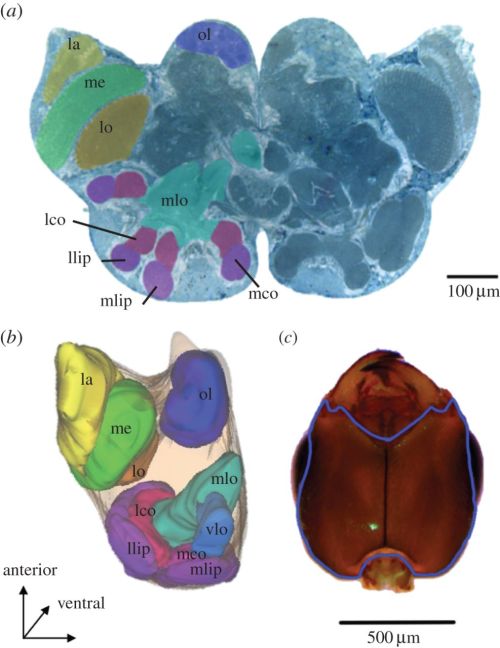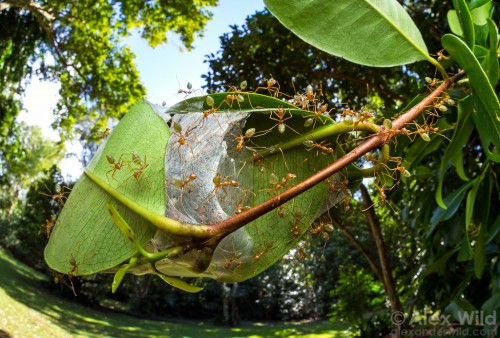It has recently been brought to my attention that there may be followers of this now-defunct blog that are not aware of the newer, greater myrmecological endeavor that has been up and running strong for the past 6 months or so: Check out The Daily Ant for all your fantastic formicid news!
A report by Discovery News with a rather straightforward title:
Lonely Ants Die Young and Hungry
I just hope they can find a little love during the upcoming Valantine’s Day.
Posted in Ant Gastronomy, Ant Publication | Leave a Comment »
Today, I came across this picture:
This is Figure 1 from a massive manuscript on Cephalotes by de Andrade and Baroni Urbani (1999). It includes the following caption:
Aerial view of one of the lines of Nasca (Peru) representing abstract animal contours (left) and the contour of a worker of Cephalotes atratus (LINNAEUS) drawn in the same style (right). The Nasca design was interpreted as a spider, essentially because it has four pairs of legs. We contend that the Nasca design might refer to a cephalotine ant as well. The reasons for this claim are twofold: (1) cephalotines are much more common and impressive than spiders, and, (2) the Nasca design bears a typical insect character contradicting the spider interpretation, namely the separation between head and thorax. This latter character is considered as being of easier observation than the number of appendages.
I find this interpretation to be quite compelling. At the very least, it’s entertaining to think that the pre-Columbian Nazca people appreciated turtle ants so much that they incorporated them into such fascinating artwork. We really shouldn’t be surprised if this is this case – turtle ants are famous for their well-documented behavior of using their heads to block the nest entrances, and several species have highly specialized soldiers so dedicated to this form of defense that their heads are basically just saucers:

(Image: Alex Wild)

(Image: Alex Wild)
Although the true inspiration for these Nazca lines may never be known for certain, I’m adding this to the pile of evidence that clearly shows that cultures around the world hold a timeless appreciation for ants.
Citation
De Andrade, M. L. and Baroni Urbani, C. Diversity and adaptation in the ant genus Cephalotes, past and present. Stuttg. Beitr. Naturk. Ser. B (Geol. Paläontol.) 271:1-889.
Posted in Ant Art, Ants and Humans, Antsy Thoughts, Myrmecological Supremacy, Spiritual Ants | Leave a Comment »
Posted in Ant Art, Ants and Humans, Cinemants, Myrmecological Supremacy | Leave a Comment »
Ants may be tiny, but they still have brains. In fact, a recent study by Amador-Vargas et al. has shown that studying these tiny brains can yield interesting discoveries about colony processes and, potentially, the evolution of division of labor in insect societies.
The researchers set out to test two hypotheses, the “task specialization hypothesis” (TSH) and the “social brain hypothesis” (SBH). In the context of ants, the TSH predicts that growth in colony size will favor unequal growth in brain size, with ants in different roles exhibiting growth in different regions of the brain (corresponding to their different tasks). In other words, large colony sizes promote task specialization, which in turn drives cognitive differentiation between individuals. Alternatively, the SBH predicts that due to an overall increased requirement for cognitive function (e.g. nest mate recognition) in larger social environments, total brain volume should increase throughout the colony, regardless of task, as colony size increases. Here, Amador-Vargas et al. particularly focus on mushroom bodies (MB), the “integration centres of the brain”, in the acacia ant Pseudomyrmex spinicola.
The study produced several interesting findings, but the key discovery is that, at least in these ants, an increase in colony size does seem to drive some cognitive differentiation (in accordance with the TSH). That is, larger colonies tended to include ants that more consistently stuck to one task, and also exhibited increased differences in brain sizes between ants dedicated to defense and those tasked with foraging for food.
The exciting thing about this finding is that it may be one step towards understanding how a division of labor evolves in insect societies. Potentially, a growth in average colony size for a species may increase the likelihood that it will evolve castes – that is, workers that are morphologically and (often) functionally distinct. The species studied here contains workers that are “monomorphic” (i.e. without physically distinct castes), as opposed to “polymorphic” (i.e. with physically distinct castes). However, future comparisons of the brains in different species spanning a full range of polymorphism would help to elucidate whether or not the trends observed in this study represent one case of a general phenomenon in which an increase in colony size drives not just behavioral but also cognitive differentiation between individuals. Such cognitive differentiation may provide a link between monomorphism and polymorphism in ant societies.
Posted in Ant Brains, Ant Publication | Leave a Comment »
When I tell friends and acquaintances that I studied the impact of bison on ants, a common first expectation is that the bison are stomping on or eating the tiny gals. This is not really the case (bison actually increase plant diversity, which is expected to indirectly increase ant diversity), but I’ve always thought the image of bison eating ants a rather amusing one:
But now, the joke’s on me: A recent study by Joshua Grinath et al. has shown that black bears increase the reproductive success of local plants by eating ants. As reported in a review in Science:
Grinath came upon another predator-plant connection while studying the partnership between ants and treehoppers on a common plant called rabbitbrush. These tiny sap-sucking insects secrete a sugary liquid the ants eat in return for taking care of the treehoppers. One summer, a bear moved into Grinath’s study site and started digging up the underground ant nests, eating both larvae and adults. So he decided to see what effect the bears had on his study subjects. …
The ants aren’t directly harming the plants, he and colleagues concluded after a series of field experiments. Instead, the presence of the ants scares off predatory insects, in turn enabling treehoppers and other plant-munching insects to thrive and take a serious toll on plant growth. “The ants are providing an enemy-free space for all these herbivores,” Grinath says. Where bears have eaten the ants, predators return and help protect the plants, he and his colleagues reported online ahead of print in Ecology Letters.
Such indirect interaction cascades are part of what makes ecology so interesting, but also rather daunting. Grinath was lucky to have been in the right place at the right time to observe the bears eating ants (the more times I get to write that phrase, the better). Otherwise, who would have proactively investigated the impacts of bears eating ants? Bears eating ants is not something one expects. In fact, even this case of bears eating ants involves a relatively simple system with a limited scope – who knows the full breadth of impacts caused by bears eating ants? Plus, it took four years for the researchers to discover what they did about bears eating ants. Still, it is exciting to know that bears eat ants, and that this consumption is an important factor in the reproductive success of local plants.
Posted in Ant Publication, Ants and Bears, Ecological Endeavors | Leave a Comment »
To resume the Monday Manadarin Meanings series, I present:
This is zhīyè yǐ, the Mandarin Chinese word for the weaver ant. “Weaver ant” is the common name for the ant genus Oecophylla, so called because of the magnificent nests they construct in the trees by binding together leaves using silk produced from their own larvae:
(Image from Alex Wild)
The Chinese word for this interesting ant is rather straightforward, with 织叶 (zhīyè) meaning “weaver” and 蚁 (yǐ) meaning “ant” (of course). However, breaking down “织叶” further, we see that “weaver” here is specifically referring to “weaving leaves”: “织” means “to weave” and “叶” means “leaf”. So, yet again, we see that the Chinese common name for an ant is more biologically informative than its English counterpart.
Posted in Monday Mandarin Meanings | Leave a Comment »
It has been about 8 months since my last post, and since then I have returned from China and begun my Ph.D. program in the Committee on Evolutionary Biology at the University of Chicago. More information on this work is here.
To start off the resumption of my blogging, I leave you with today’s NPR story on ants and how they prevent traffic jams: here.

(iStockphoto image from the NPR piece)
Posted in Ant Physics, Ants and Humans, Ants in the News, Myrmecological Supremacy | Leave a Comment »
Somewhere in Bolivia, two men decided to steal some motorcycles. They were excited about their loot, until they ended up being tied to a tree with venomous Pseudomyrmex triplarinus ants. This, as reported via the Associated Press in The Guardian and The Washington Post, was the near-fatal penalty suffered by these two miscreants for their ill-advised behavior. Unfortunately, this isn’t the only tragedy in this story.
In both newspapers, the portrayal of the key players – the insects – is horribly botched. The Guardian refers to the “venom of fire ants” in the caption of what looks to me to be a beetle (certainly not an ant), and fails to follow basic conventions like capitalizing the name of the genus “Pseudomyrmex” and italicizing the entire scientific name. The Post mercifully spares us a photo, but sticks “fire ants” in the title of its article that contains the same egregious errors as the one in The Guardian (having essentially identical AP-sourced content).
Pseudomyrmex triplarinus is completely different from fire ants. Completely different. Two-second Google search different. So is the difference between an “ant” and a “beetle”. And failing to properly capitalize and italicize the scientific name betrays the scientific illiteracy of the writer. But, despite these errors, the intriguing nature of the story makes it worth a read.
Posted in Ants and Humans, Ants in the News, Bio Blunder | 2 Comments »
Here in China, the Jewish holiday of Passover has arrived. So today’s entry for Monday Mandarin Meanings has nothing to do with insects, but instead relates to bread:
This is wújiàobǐng, the Mandarin word for matzo (generally pronounced “maht-suh”, for all you Gentiles out there). Matzo is unleavened bread, or bread that has not risen, typically meaning that it has no yeast. This is the cracker-looking bread eaten on Passover to commemorate the Jewish people’s flight from bondage in Egypt, during which there was not enough time for the bread to rise. Reasonably, the Chinese word translates into something like “unleavened flatbread” (“无” is “no” or “not”, “酵” is “leaven”, and “饼” is the word often used for flat breads, pancakes, etc.).
I purchased three boxes of matzo from Taobao, the Chinese version of Amazon.com, and, remarkably, they arrived from Hong Kong in three days. It is a non-kosher, Kupiec brand matzo with “provence herbs”, but it does the trick.
Posted in Monday Mandarin Meanings | Leave a Comment »






